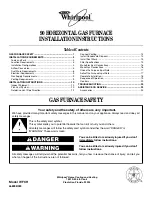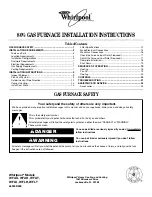
Vent system or vent connectors may need to be resized. For any
other appliances when resizing vent systems or vent connectors,
system or connector must be sized to approach minimum size as
determined using appropriate vent sizing table found in the NFGC
or NSCNGPIC.
B.
Combustion-Air and Vent Piping
GENERAL
Combustion-air and vent pipe, fittings, primers, and solvents must
conform to American National Standards Institute (ANSI) stan-
dards and American Society for Testing and Materials (ASTM)
standards. See Table 5 for approved materials for use in the U.S.A.
See Table 7 for maximum pipe lengths and Fig. 37, 38, 39, 40, and
41 for exterior piping arrangements.
In Canada, construct all combustion-air and vent pipes for this unit
of CSA or ULC listed schedule-40 PVC, PVC-DWV or ABS-
DWV pipe and pipe cement. SDR pipe is NOT approved in
Canada.
NOTE:
Furnace combustion-air and vent pipe connections are
sized for 2-in. pipe. Any pipe size change should be made outside
furnace casing in vertical pipe. (See Fig. 33.) This allows proper
drainage of vent condensate.
Combustion-air and vent pipes must terminate together in same
atmospheric pressure zone, either through roof or sidewall (roof
termination preferred), using accessory termination kit. See Table
5 for required clearances.
NOTE:
Slope combustion-air and vent pipes a minimum of 1/4
in. per linear ft with no sags between hangers.
Furnace combustion-air and vent pipe connections must be at-
tached as shown in Fig. 34. Combustion-air intake plug fitting and
inducer housing alternate vent cap may need to be relocated in
some applications.
CAUTION:
MINOR PROPERTY DAMAGE
Failure to follow this caution may result in water damage
from condensate dripping.
When combustion-air pipe is installed above a suspended
ceiling, pipe must be insulated with 3/8-in. thick
Armaflex-type insulation. Combustion-air pipe should
also be insulated when it passes through a warm, humid
space.
CAUTION:
UNIT MAY NOT OPERATE
Failure to follow this caution may result in intermittent
unit operation.
When vent pipe is exposed to temperatures below freez-
ing, such as when it passes through an unheated space or
when a chimney is used as a raceway, pipe must be
insulated as shown in Table 8 with Armaflex-type insu-
lation.
CAUTION:
UNIT CORROSION HAZARD
Excessive exposure to contaminated combustion air may
result in safety and performance related problems.
Combustion air must not be taken from inside structure
because that air is frequently contaminated by halogens,
which include fluorides, chlorides, bromides, and iodides.
These elements are found in aerosols, detergents,
bleaches, cleaning solvents, salts, air fresheners, adhe-
sives, paint, and other household products. Locate
combustion-air inlet as far as possible from swimming
pool and swimming pool pump house.
TABLE 5—APPROVED COMBUSTION-AIR AND VENT PIPE, FITTING AND CEMENT MATERIALS
ASTM SPECIFICATION
(MARKED ON MATERIAL)
MATERIAL PIPE FITTINGS SOLVENT CEMENT AND PRIMERS
DESCRIPTION
D1527
ABS
Pipe
—
—
Schedule-40
D1785
PVC
Pipe
—
—
Schedule-40
D2235
For ABS
—
—
Solvent
Cement
For ABS
D2241
PVC
Pipe
—
—
SDR-21 & SDR-26
D2466
PVC
—
Fittings
—
Schedule-40
D2468
ABS
—
Fittings
—
Schedule-40
D2564
For PVC
—
—
Solvent
Cement
For PVC
D2661
ABS
Pipe
Fittings
—
DWV at Schedule-40 IPS sizes
D2665
PVC
Pipe
Fittings
—
DWV
F438
CPVC
—
Fittings
—
Schedule-40
F441
CPVC
Pipe
—
—
Schedule-40
F442
CPVC
Pipe
—
—
SDR
F493
For CPVC
—
—
Solvent
Cement
For CPVC
F628
ABS
Pipe
—
—
Cellular Core DWV at Schedule-40 IPS sizes
F656
For PVC
—
—
Primer
For PVC
F891
PVC
Pipe
—
—
Cellular Core Schedule-40 & DWV
Fig. 33—Combustion-Air and Vent Pipe Diameter
Transition Location and Elbow Configuration
A93034
FURNACE
PIPE DIAMETER
TRANSITION IN
VERTICAL SECTION
NOT IN
HORIZONTAL
SECTION
—25—
Summary of Contents for CONDENSING GAS FURNACE 355MAV
Page 51: ... 51 ...
















































